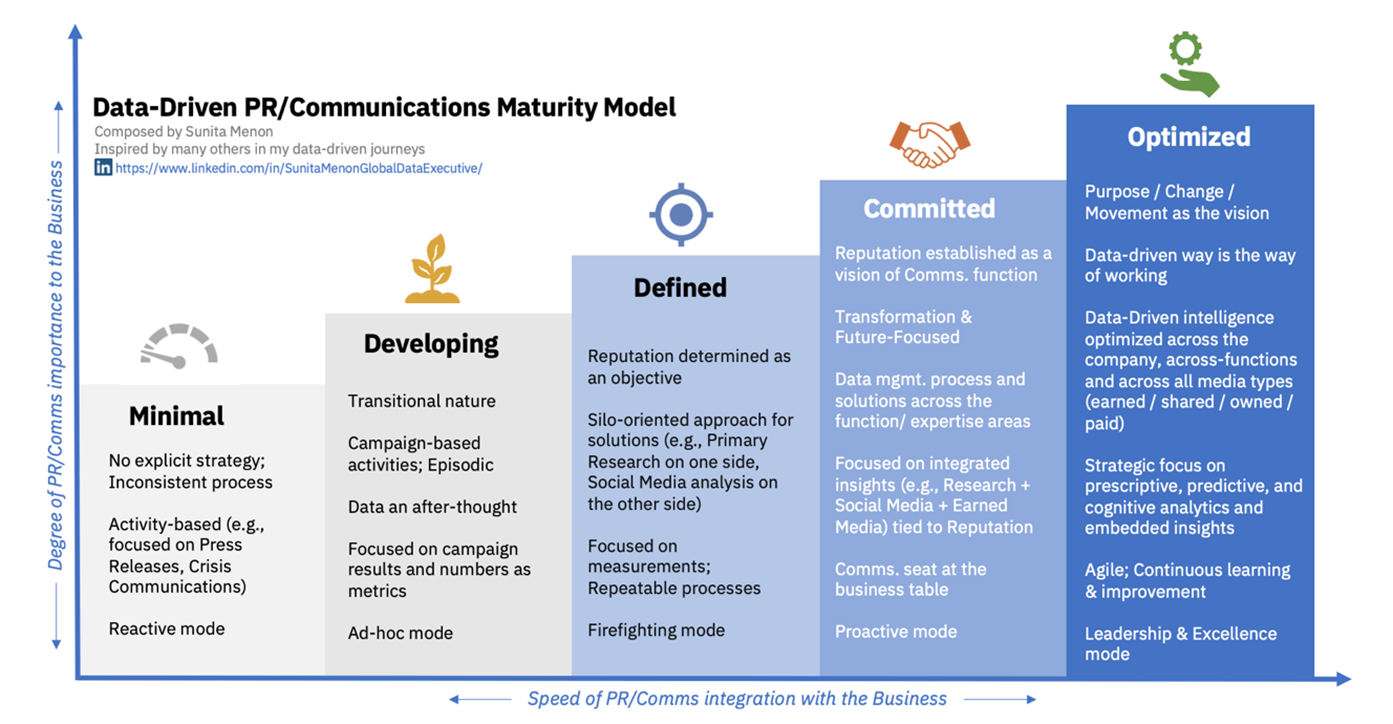Measurement is meaningless without a careful data strategy
Here’s how to ensure you are being intentional to make a data-powered business impact.

“It is relatively easier to teach communications to a data person than teach data to a communications person,” quipped my communications colleague as we introduced each other my second day on the job a few years ago. I had just joined the Global Communications team in IBM after 20+ years of working on all things data for IBM’s sales, marketing, finance, and enterprise transformation.
I was excited about the opportunity and the journey of data-powered transformation for PR/Communications business processes.
Having come from the business side of data, I am keenly aware of the people, process and technology dimensions that go into any business transformation initiative. Here, I am sharing a perspective of data-driven PR/communications from a business and strategy viewpoint.
Through the first few months of learning the PR/Communications organizational landscape, it was insightful to know that culturally the term “data-driven” was almost always used as a synonym for “measurement” or vice-versa—and not just in the company but in the industry. To me, this trend almost instinctively explained to a large extent the confusion and the somewhat tactical nature of data programs, where the means (measurement) was deemed as the ends.
Measurement is not a bad thing. The question is, where is it taking you?
Suppose you were going on a road trip, and I asked you, “What will you measure?” You might say: time, distance, route, traffic, weather, number of stops you might make, etc. But, if I asked you, “Why are you going on this road trip?” You might say: to have fun, make memories, adventure, for convenience etc. What you measure will be different depending on the question.
Similarly, in PR/communications, data-driven ways of working become powerful when the questions they can answer are also powerful. If you start with compelling business questions, you will find compelling business insights. In addition to metrics, you will also receive insights that will help you and the business make better decisions and drive superior outcomes.
Data-driven PR/communications cannot be about justifying existence, seeking additional budget—and not measurement for the sake of it. It must be designed and implemented as a strategic method for deriving insights to business questions and thereby influencing outcomes.
A PR/communications professional is always a business professional first, before they are an expert in copy writing, crisis communications, content management, employee communications etc., and therefore must approach data-driven ways of working with a business mindset.
Typically, PR/Communications organizations evolve through different stages of evolution in their data-driven journey.

Here are the six most critical design points for an effective data strategy for PR/communications:
- Ask the right questions. Start with understanding the business objectives before setting PR/communications objectives. Understand how the business runs, and how it provides value to its constituencies. As a business professional, ask, “How can we build/improve corporate reputation (what others hear, think, believe and feel about the company) for our business across our multiple stakeholder audiences? What is the story of our business?” Find the why of your business, then establish your corporate reputation objectives and drivers aligned with it.
- Approach with a full view of stakeholder audiences of PR/Communications. Those audiences include customers, prospects, media, employee, investors, analysts, business partners, suppliers and the general population. Include not only current, but future audience sets as well, e.g., current employees and investors but also future employees and investors.
- Align your data focus to the “why” of your business. Use the “why” of your business to define your data set, methods and processes. Start with an outcome and hypothesis, then evaluate and refine. Most data-focused teams in any industry, typically follow this data journey, moving from one phase to the other as both the data and the program matures:
- What happened? (descriptive)
- What is happening and why? (diagnostic)
- What will happen next? (predictive)
- How can we make it happen? (prescriptive)
- What is the best that can happen? (cognitive)
- Aim for actionable insights. If you don’t want your data program to get caught up in “measurements” (the means), steer it towards insights that will help make business decisions and drive actions and outcomes (the ends). This focus will in turn will enrich the data and further increase the value you can derive from data.
- Amplify your business storytelling capabilities with data. Data storytelling can bring the art and science of PR/communications together to connect with your multiple stakeholder audiences in authentic and inspiring ways.
- Activate a data mindset. Start with data, rather than making it an afterthought. Seek to derive directionally accurate views versus seeking precision (unless it is a matter of life and death), staying curious through the discovery and analytics process, proving the hypothesis and, enriching the data/insights as you go along.
The name of this game is bringing the right story, to the right audience at the right time, through the right channel to drive communications outcomes for the business. Data can be your partner/advisor in every step of this journey. You need data for analytics, but you need insights for business success.
Sunita Menon is an adjunct professor at the University of Florida College of Journalism and Communication and a global data strategist and advisor. Connect with her on LinkedIn.







What we should try to measure is what the company got for the money spent on us. That measurement could help the boss and help our careers.